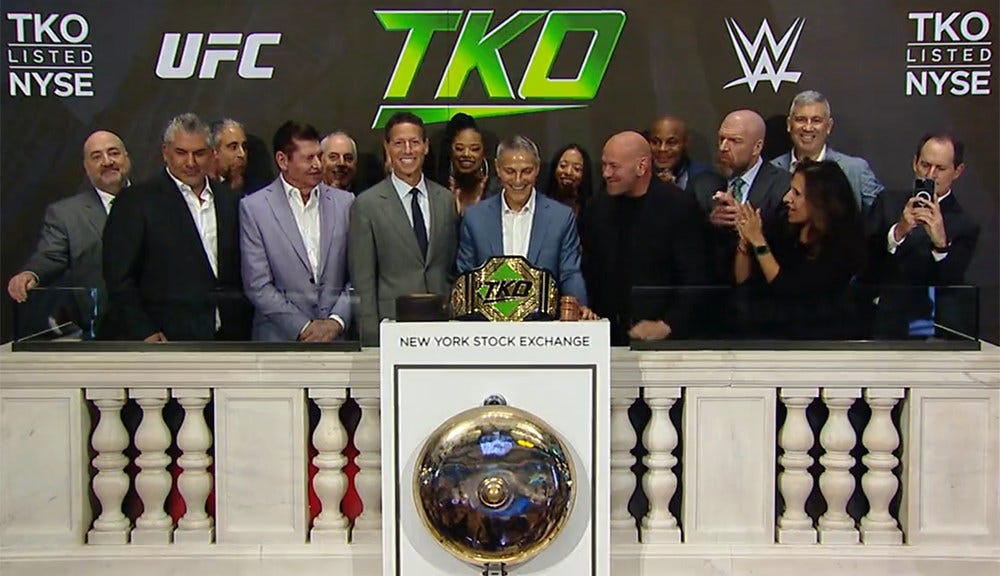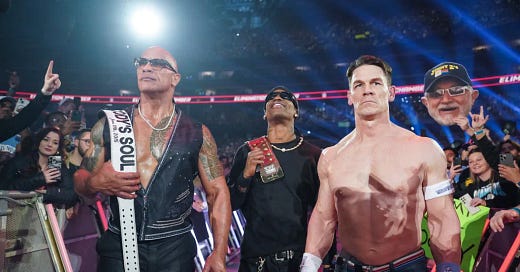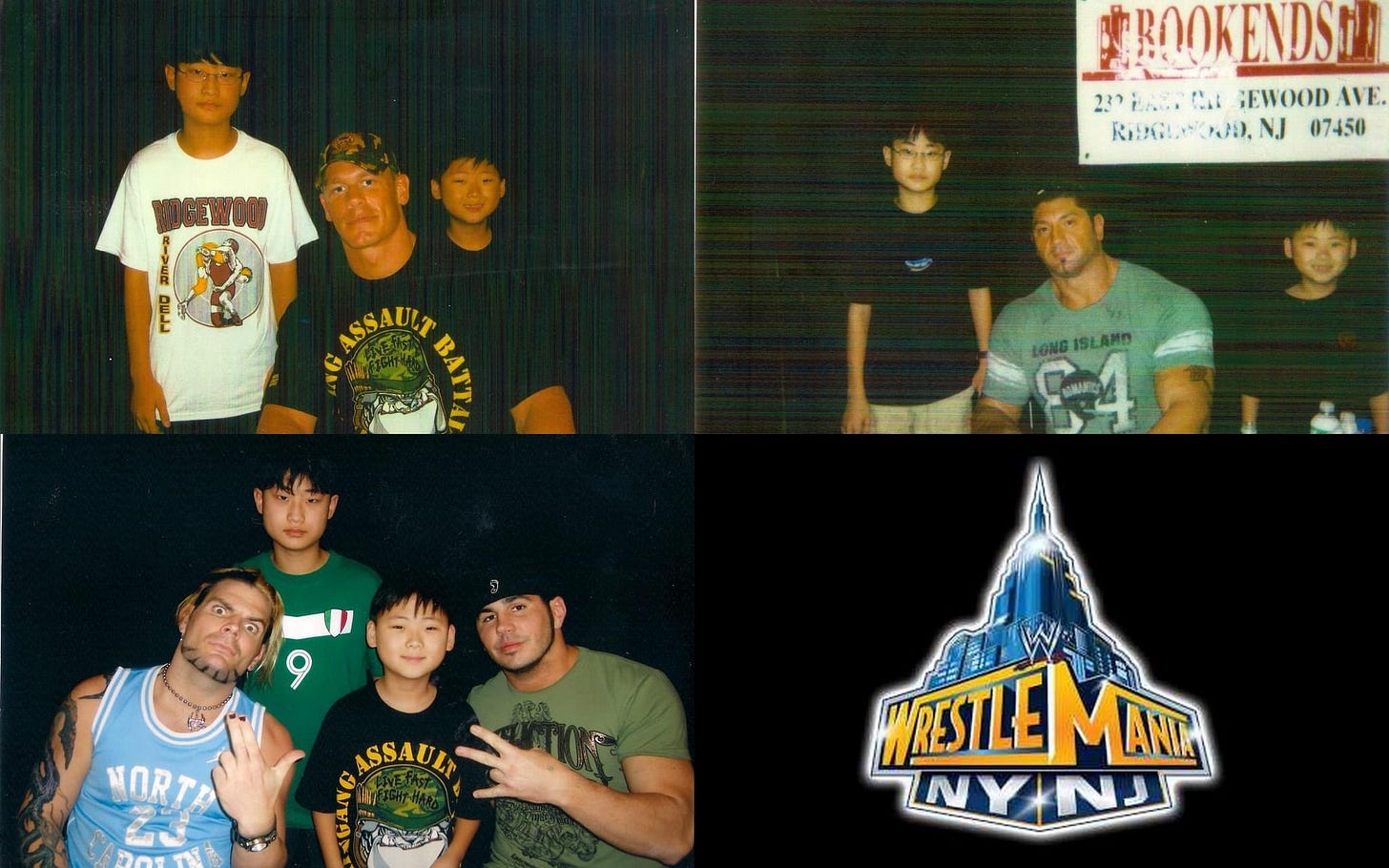It’s WrestleMania weekend! Professional wrestling, specifically World Wrestling Entertainment (WWE), is not only delivering culturally relevant content but also consistently well-rounded, high-quality shows every week.
If you have Netflix, you may have seen vignettes of WWE Monday Night Raw, WWE’s flagship program, which began streaming earlier this year thanks to a new exclusive deal. Personally, I find Netflix’s layout super convenient—not only for tuning in live, but also for rewatching episodes later in the week. The other marquee show, WWE Smackdown!, is currently a Peacock exclusive, but I predict it will move to Netflix too when the deal expires.
My biggest caveat over the years with WWE programming, and why I drifted away, was that I no longer had cable TV nor the bandwidth to watch live each week like I did when I was 11. My Netflix subscription has solved that easily, and now I feel more engaged with the product instead of just catching highlights on Instagram.
In this post, I’ll break down a few topics that make WWE fascinating—from its business and tech strategies, to its cultural resurgence and my own emotional connection to the product.
The Renaissance Era
Before I dive into the finer details, I’ll provide the groundwork first.
WWE is currently in what’s being called the Renaissance Era. You may have heard of the Attitude Era—the period when household names like “Stone Cold” Steve Austin and The Rock (yes, that Dwayne Johnson) dominated prime-time TV and caused all kinds of chaos. These eras are typically defined by major shifts—either in storyline, business operations, or both.
WWE has always been deeply intertwined with pop culture, though it’s sometimes seen as a bit niche. Despite high-profile celebrity appearances and major sponsorships over the past decade, I’ve felt that WWE remained mostly catered to its core fanbase—and that its presence in the mainstream media landscape had declined.
I noticed a shift in 2022, when former Chairman and CEO Vince McMahon faced sexual misconduct allegations ultimately led to his retirement (or resignation, depending on how you see it). For a quick overview of McMahon’s role in WWE, I recommend the Netflix documentary “Mr. McMahon.” While it doesn’t delve deeply into the scandals, it does provide a broad biography of his legacy.
So that shake-up naturally paved the way for McMahon’s son-in-law—legendary wrestler Paul “Triple H” Levesque and current Chief Content Officer—to have greater influence over creative direction. He now oversees storyline development, talent management, and the overall vision. Under his leadership, I’ve noticed the stories are more coherent, superstar roster is diverse, and that the company feels like it’s actually thinking long-term, with a dedicated team at the helm rather than decisions hinging on one man’s whims.
We’re currently in the midst of Cody Rhodes’s reign as WWE Universal Champion. He returned to WWE in 2023 after a hiatus, to major fanfare. Now, he stands as the current “face of the company”—following in the footsteps of iconic figures like Hulk Hogan, “Stone Cold” Steve Austin, The Rock, John Cena, and Roman Reigns. WrestleMania 41 is WWE’s biggest event of the year, taking place over two nights of live shows this weekend—plus more than a week’s worth of immersive festivities if you're in Las Vegas.
The Business Direction
What’s fascinating about WWE is that it’s a business built on not just its own superstars and brands, but also on strategic partnerships.
The Streaming, Tech, and Social Media
The aforementioned Peacock and Netflix deals were game-changers, but WWE was actually ahead of the curve in 2014 with its own OTT streaming platform, “WWE Network.” It ran for 11 years before shutting down in 2025 and has since been merged into Peacock. WWE was never a tech company, so it was never going to truly compete with the likes of Hulu or Netflix. But what’s important to recognize is how evergreen WWE content is. Fans constantly go back to rewatch classic matches and segments—like Undertaker v. Mankind (1998), Dr. Steve Austin (1998), the infamous TLC Match (2001), Batista’s breakthrough (2004), the CM Punk Pipebomb (2011), the Yes! Movement (2014), and Becky Lynch, The Man (2019) — moments that remain just as entertaining years later.
The advantage of streaming is that it gives fans access to an entire library of content, available on demand anytime. WWE recognized early and simply capitalized on this better and sooner than many of its peers.
According to Nick Khan, CEO and Paul Levesque, CCO on
podcast:We’re a wonderful blend of sports and entertainment, and we resonate in a different way than anything else does. Globally for us, it’s simple - it resonates everywhere. The opportunity that we have through streaming is just to amplify that. With our talent, with that amplification, we can recruit globally. We can begin to create bigger stars internationally as well as stars in the U.S. and have them resonate everywhere. While we’re globalizing, we are also localizing.
This is further bolstered by the YouTube metrics - 108 million subscribers as of April 2025, more than any other sports league combined. As I’ll explain with my personal anecdotes in a bit, the WWE has always felt both ubiquitous and timeless.
The Big Deal
Let’s discuss deals.
In September 2023, WWE announced a merger with Ultimate Fighting Championship (UFC) and Endeavor under a newly formed, publicly traded holding company: TKO Group Holdings, in a $21.4B deal. The fanboy in me was going wild. While I’d mostly been focused on watching UFC over the past few years, I knew this merger would reignite my enthusiasm for WWE too.

Oddly enough, the deal closed after McMahon’s sexual scandal, and it actually led to his un-retirement — he initially served as TKO’s Executive Chairman. However, after another sexual allegation surfaced, McMahon passed the reins to Endeavor’s Ari Emanuel in 2024.
During this time, I kept a close eye on events to see if WWE would finally transition to a new generation of leadership. It was a rollercoaster ride, but then again, it wouldn’t be WWE without the real-life drama.
The UFC-WWE relationship is also fascinating.
Shane McMahon, Vince’s son, had actually pitched the idea of buying the UFC in the early 2000s. Back then, the UFC was a far cry from what it is today; it was still very much a ‘hardcore’, cultish sport, largely perceived as something for wild male audiences. It’s unclear what would’ve happened if that deal had gone through, but I think both companies fared better in merging in 2023 instead.
Historically, there have also been crossover stars like Ken Shamrock, Brock Lesnar, and Ronda Rousey, that soared to mainstream stardom in both WWE and UFC. Even former UFC champion Conor McGregor’s persona draws inspiration from Vince McMahon’s iconic on-screen character. WWE superstar CM Punk had a less than memorable UFC run, but no shame in embarking on a new challenge.
More importantly, I believe the TKO brand significantly strengthens the expertise and market positions of both WWE and UFC in the sports entertainment world. With Endeavor as a majority owner, the cross-promotional opportunities are abundant, and we’ve seen some of this unfold. There’s even a new boxing promotion being formed as part of a TKO-Saudi Arabia partnership. Additionally, with the previous ESPN deal expiring, there are rumors of UFC pay-per-view events may soon sign with Netflix as well.

This is media consolidation at its finest in the sports entertainment industry—a new era for organizations that were once seen as niche, edgy, and even "carny."
The Celebs
Celebrities have always been part of the WWE. Logan Paul held a WWE championship title and he’s very, very good.
Interestingly, Khan and Levesque touch on what changed for celebrity involvement:
It used to be that people from outside of wrestling would come to us on the down side of their career. Now what you’re seeing - Floyd Mayweather, Tyson Fury, broadcasters [Pat McAfee] coming on the ascent of their careers. People want to want to be here. Bad Bunny set a new bar…he did everything asked of him and beyond…Celebrities want to come work with us [now]. They’re massive fans. Travis Scott was like a little kid jumping up and down.
Of course, long-time staples like Donald Trump or Snoop Dogg have been in and out of the WWE for years. But what I appreciate about the celebrity partnerships today is that they feel trendy. Top celebrities like Tyson Fury, Bad Bunny, Logan Paul, and iShowSpeed are wrestling matches. Travis Scott is part of one of the most shocking moments in recent history and teased a fashion collaboration. PRIME Hydration is an official sponsor of the WWE (and the UFC). The Weeknd’s songs have been selected as official WrestleMania themes for 6 consecutive years.
It truly feels like different facets of the pop cultural zeitgeist - ball sports, combat sports, music, gaming, influencer, etc. - are now reflected in pro wrestling of all things.
My Story
So if you knew me from elementary and middle school, you definitely knew that I was obsessed with WWE.
But even before that, when I was a first grader in Seoul, cable TV would always air RAW or Smackdown! on the weekends. Somehow, I came across a random match - Edge v. Test (RIP) in 2001 - which was my first introduction to the show. It was a bit violent for my young self so I forgot about it, until I moved to the U.S. and got swept up in the edgy American pop culture of the early 2000s.
At that time, John Cena was dropping rap songs, Dave Bautista (now better known as an actor) was powerbombing people every week, and the Hardy Boyz were inspiring a generation of kids to flip around on trampolines. Luckily, I got the chance to meet these stars when my neighborhood bookstore hosted autograph signings. I still remember John Cena’s huge hand and his friendly handshake. Thanks again, John!
In college, I sometimes attended WWE watch parties with strangers. It’d be awkward at first, but by the end we were all hyped and cheering together. WrestleMania 31 even happened nearby when I was a junior, and I guess I kind of regret not going. I did catch a live Smackdown! however:
What got a shy Asian kid like me hyped about WWE were the larger-than-life characters and my fascination with combat sports. I think this resonates with a lot of people—we grew up somehow watching pro wrestling on cable TV, drifted away as we became adults, only for it to find us again.
Of course, WWE was always there—and it probably will be for a long time, as it continues to evolve. But with a quality product and even easier access, it’s bound to not only awaken nostalgia but also recapture former fans like myself. Pro wrestling is meant to be fun, vibrant, and flashy. It’s a world of heroes, villains, and chaos, which mirrors much of what we encounter in the adult world.
John Cena is in the middle of his retirement run and his first villain (“heel”, in wrestling lingo) arc, and everyone is hyped. To borrow from the famous Batman quote: “You either die a hero or live long enough to see yourself become the villain.” Perhaps what truly gets us adult fans excited is not just seeing our childhood hero deliver one final time, but also reliving the special emotional connection we felt when we were younger.
If you found this piece intriguing, or can’t relate to what I’m talking about at all, maybe it’s time to tune in.
Thanks for reading!
I have been settling into my new position, and it’s been a great experience so far. I hope to keep up the momentum and work on a few more write-ups on interesting topics this month and the next before summer arrives (time flies!).
Pro wrestling was a big part of my livelihood, and I’m surprised it took me awhile to reconnect for it to deserve a separate piece. There’s probably more related to this topic that I could explore, and I will likely tackle the UFC down the road.
I’ve been getting a lot of inbound requests for informative calls lately, especially from students. I think that was to be expected and I’m trying to work out a system to be helpful. But nonetheless, if you’re in any of the music/entertainment-adjacent spaces, happy to (re)connect!
-Wooseok Ki (Wooski)





